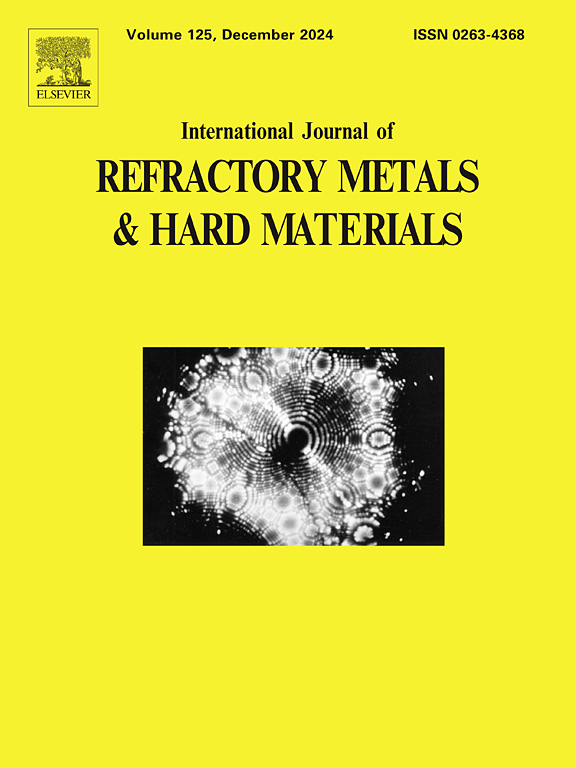Enhancing strength-ductility in fine-grain More alloy fibers
IF 4.2
2区 材料科学
Q2 MATERIALS SCIENCE, MULTIDISCIPLINARY
International Journal of Refractory Metals & Hard Materials
Pub Date : 2025-07-17
DOI:10.1016/j.ijrmhm.2025.107335
引用次数: 0
Abstract
Super-high strength (∼ 2.4 GPa) is obtained in fine-grain Mo![]() Re alloy with ignorable ductility at room temperature, which is attributed to fine grain size and high stress concentration induced by thermal-mechanical processing. The processing-induced stress could not fully release at 800 °C annealing for 1 h. The second σ phases precipitating at 1100 °C annealing without obvious spheroidization in columnar grains, providing a comprehensive match between strength (1.25 GPa) and ductility (20 %) at room temperature. Strength remarkably drops after annealing at 1400 °C and 1500 °C with ductility nearly unchanged. Both strength and ductility decrease obviously after annealing at 1600 °C and 1800 °C. The average grain size in 1800 °C annealed sample is nearly twice as in 1600 °C annealed one. Enhanced strength in as-deformed fibers is dominated by fine grain-strengthening, although a large amount of soft [110] texture occurs. Excellent match between strength and ductility may be attributed to the recovery and [112] texture that happens in 1100 °C annealed fiber. What is more, nano-meters σ particles are detected along grain boundaries in 1100 °C annealed fiber, providing an extra strengthening route. In other annealed fibers, the growth of grain size leads to the decrease in strength.
Re alloy with ignorable ductility at room temperature, which is attributed to fine grain size and high stress concentration induced by thermal-mechanical processing. The processing-induced stress could not fully release at 800 °C annealing for 1 h. The second σ phases precipitating at 1100 °C annealing without obvious spheroidization in columnar grains, providing a comprehensive match between strength (1.25 GPa) and ductility (20 %) at room temperature. Strength remarkably drops after annealing at 1400 °C and 1500 °C with ductility nearly unchanged. Both strength and ductility decrease obviously after annealing at 1600 °C and 1800 °C. The average grain size in 1800 °C annealed sample is nearly twice as in 1600 °C annealed one. Enhanced strength in as-deformed fibers is dominated by fine grain-strengthening, although a large amount of soft [110] texture occurs. Excellent match between strength and ductility may be attributed to the recovery and [112] texture that happens in 1100 °C annealed fiber. What is more, nano-meters σ particles are detected along grain boundaries in 1100 °C annealed fiber, providing an extra strengthening route. In other annealed fibers, the growth of grain size leads to the decrease in strength.
提高细晶More合金纤维的强度-延展性
在室温下,细晶MoRe合金获得了超高强度(~ 2.4 GPa),但塑性可忽略不计,这是由于晶粒细和热机械加工引起的高应力集中所致。800℃退火1 h后,加工引起的应力不能完全释放。1100℃退火时,第二σ相析出,柱状晶粒无明显球化,室温强度(1.25 GPa)和塑性(20%)基本匹配。在1400℃和1500℃退火后,强度显著下降,延展性基本不变。在1600℃和1800℃退火后,强度和塑性均明显下降。1800℃退火试样的平均晶粒尺寸几乎是1600℃退火试样的两倍。形变纤维的强度增强主要以细晶强化为主,但也会产生大量的软织构[110]。强度和延展性之间的良好匹配可能归因于1100°C退火纤维的恢复和[112]织构。在1100℃退火纤维中,沿晶界存在纳米级σ粒子,提供了一条额外的强化途径。在其他退火纤维中,晶粒尺寸的增大导致强度的降低。
本文章由计算机程序翻译,如有差异,请以英文原文为准。
求助全文
约1分钟内获得全文
求助全文
来源期刊
CiteScore
7.00
自引率
13.90%
发文量
236
审稿时长
35 days
期刊介绍:
The International Journal of Refractory Metals and Hard Materials (IJRMHM) publishes original research articles concerned with all aspects of refractory metals and hard materials. Refractory metals are defined as metals with melting points higher than 1800 °C. These are tungsten, molybdenum, chromium, tantalum, niobium, hafnium, and rhenium, as well as many compounds and alloys based thereupon. Hard materials that are included in the scope of this journal are defined as materials with hardness values higher than 1000 kg/mm2, primarily intended for applications as manufacturing tools or wear resistant components in mechanical systems. Thus they encompass carbides, nitrides and borides of metals, and related compounds. A special focus of this journal is put on the family of hardmetals, which is also known as cemented tungsten carbide, and cermets which are based on titanium carbide and carbonitrides with or without a metal binder. Ceramics and superhard materials including diamond and cubic boron nitride may also be accepted provided the subject material is presented as hard materials as defined above.

 求助内容:
求助内容: 应助结果提醒方式:
应助结果提醒方式:


